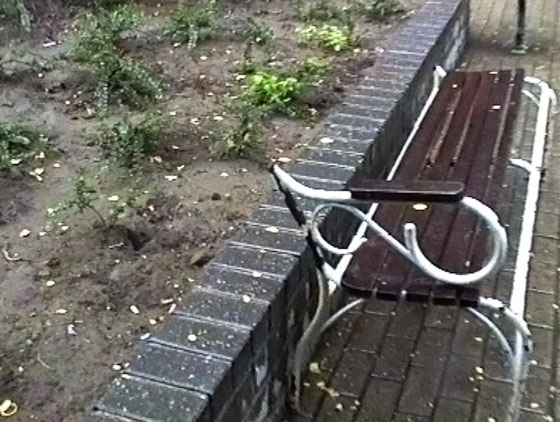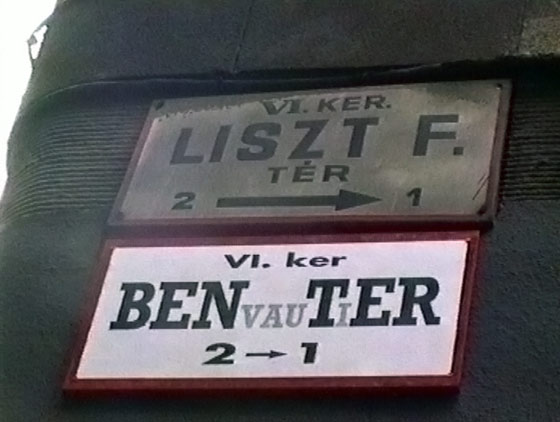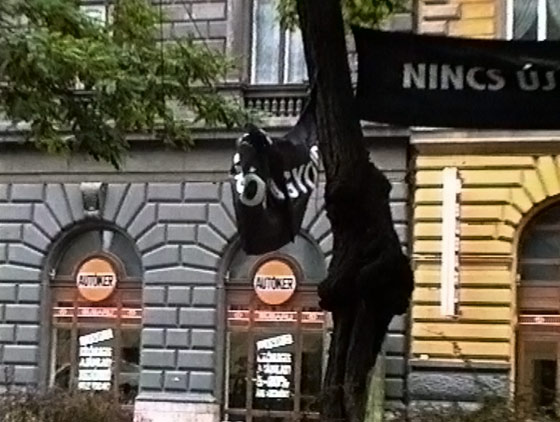Artpool events - 1 October 1993 - BEN TÉR
Appendix to "Hungarian humourism being born out of blind chance"
An account of adventures
About the war waged over the street signs that form an intrinsic part of the open-air exhibition entitled Ben tér, i.e. Ben Square, and certain individuals representing the authorities.
My approach is to start at the beginning – let me use this quote by Antal Szerb as an excuse for the relatively long account that follows.
When we were planning the style and image of the Budapest Autumn Festival, we decided to have two largish open-air programme series: traditional festivities with a flea market, antiquities, street music and happy and popular open-air programmes in the Vörösmarty Square-Danube Promenade area, as well as experimental open-air exhibitions in the vein of contemporary art festivals on Liszt Ferenc Square.

The little city square we chose to make more interesting, add a bit of colour to and thus perhaps spruce up was one that has a friendly atmosphere and (like most city parks in Budapest) is a bit down-at-heel and neglected, though home to several elegant and well known institutes of art and culture ranging from the Írók boltja [Writers’ Corner] bookshop to the Music Academy. If memory serves me well, the location and the idea originally came from the Artpool Art Research Center, but in any case they were the ones who organized the two exhibitions held so far.
(We thought of jointly organizing some programmes for children with the Kolibri Theatre at the playground on Jókai Square on the other side of Andrássy Road.)
This year György Galántai organized an exhibition using the material of the French Fluxus artist Ben Vautier, and taking advantage of the word play that can be made from the artist’s name symbolically christened the square BEN vauTiER (by inserting the artist’s name into the existing “Ben tér” or square) for the two weeks of the exhibition.
(A copy of the sign is in the appendix).

The exhibition was opened on 25 September with the personal cooperation of Dr. Tibor Seiler, the mayor of Budapest’s Erzsébetváros district, and because by a stroke of luck Jonas Mekas, an independent filmmaker and one of the leading American figures of the Fluxus movement was in Budapest - as a guest of the festival –, he was also able to participate in the opening happening. Thus, the exhibition became a little more interesting (and perhaps came to be seen as more like a cause) for the international, alternative art scene.
With the assistance of the local government of district VI we sent a letter to the residents of Liszt and Jókai squares in the week prior to the exhibition, informing them of the planned programmes for the Budapest Autumn Festival to be held in these locations. (appendix).
“now the dance begins”
On Friday (1 October) we were informed by Galántai and co. that a gentleman with an agitated voice – György Mészáros, the secretary for the Budapest Cityscape Protection Committee of the Lord Mayor’s Office - had telephoned them and asked them to dismantle the exhibition immediately since because of our silly joke visitors had mistakenly gone to Bem Square instead of Liszt Square, and, furthermore, our street signs to the exhibition were in contravention of several laws and we had not obtained any kind of permission from the police, ambulance services or fire brigade. Galántai had asked him to confirm all of this in writing since after all an exhibition can’t just be dismantled on the strength of a demand made on the telephone from somebody who for them was a stranger. At the same time they asked him to preferably fax their request to me directly (I was the festival’s secretary) since our agreement would be necessary for the dismantlement of the exhibition anyway. [György Mészáros, 2008]
At the weekend I received a copy of Mr. Mészáros’s fax to Galántai (he didn’t send one to me), and on Monday morning when I went to work I was called by Vera Szolnoki, the department head. I found out from her that Mr. Gógl, the deputy-public notary, had been asking her for information about our life-threatening exhibition. At that point I started to try and get in contact with Mr. Gógl, the deputy-public notary, whom, unfortunately, due to his other engagements, I was only able to reach on the following morning; however, I am able to assure you dear reader that I didn’t waste any of the time I gained and in addition to the odd things I had to do in connection with the dozen or so programmes in the festival I got in contact with the public authorities listed by Mr. Mészáros.
Dr. József Hatala, the director of the Department of Public Safety at the Budapest Police Headquarters, officially informed me that if the sign we had put out did not offend public decency and did not depict any prohibited political symbols – and he assumed that, based on my description of them, this was not at all the case – the police would not be dealing with the matter and that although we were under no obligation to report anything officially, he nevertheless thanked us for the information. Dropping his official role for a moment he suggested with a smile that I shouldn’t let people pull my leg.
Lieutenant-colonel Varga, the chief fire brigade officer of districts V-VI informed me in a somewhat less official way that they would indeed be in big trouble if they were unable to realise that there was a fire in Liszt Square (which is in Pest – transl.) and not in Buda. But in any case he informed me officially that we had no obligation to officially report this, although he was grateful for the information anyway and he asked us to keep him informed in advance in the future too if possible.
Dr. Lóránt Szegeczky, the chief medical officer of the Budapest Ambulance Service, said that he had already seen the signs and thought that they were a bit strange, and he hoped that we would not hold it against him that he did not especially like them, but that we were under no official obligation to report the change to them. He added that in his opinion the signs were not misleading and he found it hard to imagine that an experienced ambulance driver would go to district I in Buda after receiving a call to go to district VI in Pest. However, he added that it wouldn’t hurt to tell him in advance in the future. To my question if it was possible to identify the person that reported us to them he replied that it would involve looking for the information among the thousands of calls received every day but if we were to write an official letter specifying the name, the exact day and - if possible - the time of day the case was reported, his colleagues would try to look into it despite their workload. At the same time he reiterated that on first hearing about this matter he had found the whole thing to be somewhat incredible.
On the morning of the following day I managed to speak to Mr. Gógl, the deputy-public notary, who in a raised voice demanded that the exhibition be dismantled immediately, informing me that according to reliable sources we were putting people’s lives at risk, though he added that he did not want to go into detail on this point, and that, furthermore, he had a photo in front of him that clearly revealed that we had indeed placed new signs above the old ones in a misleading manner. When I remarked that although I had not checked all the eight signs, I definitely remembered that I saw several name-plates placed in front of or next to the originals, he protested that I was trying to discredit him and that he had an authenticated photo right in front of him that proved our illegal action. It did nothing to calm him down when I went through the results of the consultations carried out with the official bodies above. When I asked him to kindly inform – or instruct – us in writing what to do because he could surely understand that we could not do anything on the strength of a telephone call, he flatly refused and told me that I had been warned and after this what would happen would happen and that he already knew what would, and that I would see. (Just so the reader doesn’t get too alarmed I should add that in fact nothing happened. Or to be more exact, all that happened was that two days before the planned end of the exhibition, Galántai and his friends dismantled it on the Friday (8 November), since the youths that hang out in the square and the homeless could not wait two weeks, and set about tearing down the signs - despite our requests not to do so.)

That afternoon I had a look over to Ben Square and established that of the eight signs six had been placed under or next to the original street signs in Liszt Square, and in one place (on the corner of Liszt F. Sq-Király St.) they had had to place it above the Liszt Square sign because despite the law referred to in Mr. Mészáros’ letter – which, as I believe did not apply to us since our sign still couldn’t be defined as a “caption with advertising purposes”, even if the official body deprived us of the status of having created a product of artistic quality, although it is I think the duty of an art critic and not public servants – the wall under the original street sign was inundated with advertising signs, covering a roughly 3-inch-band. The eighth sign was set up between two street name signs on the wall of a pub on the corner of Liszt F. Square and Andrássy Road, since there was no other way of putting it up because of the arch of the portal. (It’s quite likely that the photo later used as evidence was later taken here but unfortunately for some reason the Liszt Ferenc square sign at the top got missed out of the picture.) The truth of what I am claiming - although I’m not reckless enough to try to disprove a notable deputy-notary – can be verified in the video documentation made by Galántai and co.
In the meantime, it turned out that the Budapest Cityscape Protection Committee had contacted the Association of City Protection, which sought out the chief architect of district VI. (or maybe it was the other way around). Mr. Péter Lantos, the chief architect – whom of course I also rang – said that he was contacted by an absolutely reliable person, Mr. Ottó Meszler /?/, who had shown him the photos documenting the misleading positioning of the signs. In his view there had been an act of gross irresponsibility and although he was “naturally” not willing to put it into writing, he informed me verbally that had a tragedy taken place, he would have known who to have to initiate proceedings against for placing people’s lives in danger while executing an official activity (I hope I have quoted him correctly because it is difficult to remember something like this just from hearing it).
After this I spoke to Katalin Litkei, the secretary of the Association of City Protection, who had also seen the photo and taking it out of context really thought that it seemed to be potentially misleading, although she also thought that if it was clearly part of an exhibition – by chance she had not in the past two weeks walked from her office to Liszt F. Square, which is ten minutes away – she believed that the accusation was not appropriate and she did not at all think that such an exhibition could spoil the cityscape. When the festival was over I visited her and showed her the documents attached here and briefly explained to her what I have described above. She assured me that in her opinion the misunderstanding had occurred because of overzealousness on someone’s part and she said that she found out in retrospect that we acquired the necessary licences and thus we should feel free to continue our exhibitions in public squares. Since such events affect her scope of activities, she asked that we inform the association in future.
Towards the weekend - after several attempts - I managed to reach Mr. Mészáros, who had been out of Budapest in the days prior to this. He explained that in his opinion and on the basis of the photo placed at his disposal we had spoiled the cityscape and that the signs, positioned as they were, were potentially misleading. He said he did not think such avantgard ideas were appropriate and that they did not fit in with the city’s traditional image, and, further to this, he indicated in a letter that the placing of captions for advertising purposes near to street signs was prohibited. After this he said that, as far as he remembered, a resident of Liszt Ferenc Square called Mező (or maybe Szegő) had called him on Tuesday and told him in indignation that his American relative had been taken ill in the square and so he had telephoned the ambulance services from there, and the ambulance had gone to Bem Square (in Buda) because of our signs. I asked him how I could get into contact with Mr. Mező in order to clear up the facts of the matter, but unfortunately he had no more information to give me. He didn’t ask for datas - said - just had merely taken the necessary measures. After this I visited him and took the necessary documentation, and this time he said in a far more pleasant voice that unfortunately he was not sufficiently informed. He added that he personally made the decisions in matters affecting the cityscape but that he was also ready to believe that the telephone call could well have been a prank. When I asked who this Mr. Meszler was - whose photo constituted reliable evidence - and how I could have a word with him, he replied that he was a very enthusiastic and somewhat of a hasty activist working for them, who therefore shouldn’t be taken too seriously and that there was no point in contacting him.
After all this my guess is that there was a school bomb scare. If only I knew which class had a maths test that day!
Budapest, 18 October 1993
Péter Máté
appendix to "Hungarian humourism being born out of blind chance"
Artpool events - 1 October 1993 - BEN TÉR
![]()
[1992] [events from '92] [new events] [Artpool] [search] [1994]